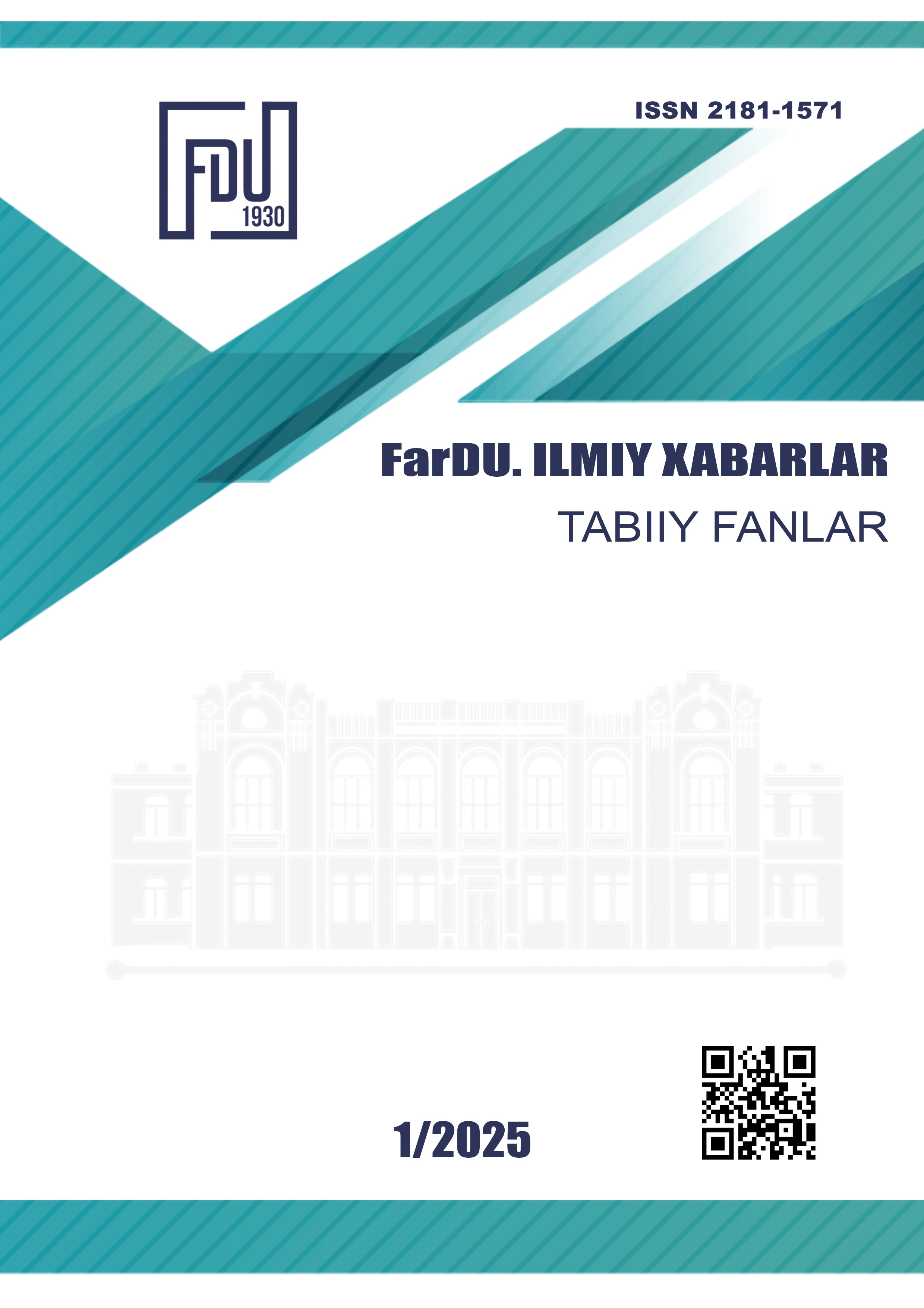GAS CHROMATOGRAPHY-MASS SPECTROMETRY ANALYSIS OF THE HEXANE FRACTION OF THE AERIAL PARTS OF LIMONIUM OTOLEPIS
Keywords:
Limonium otolepis, gas chromatography, mass spectrometry, n-pentacosane, n-nonadecaneAbstract
This article presents the results of the gas chromatography-mass spectrometry analysis of the hexane fraction of the aerial parts of the halophytic plant Limonium otolepis, which is distributed in the desert areas of the Fergana Valley region. According to the results, a total of 74 compounds were identified in the hexane fraction. Among them, 9 compounds were found to make up 92.51% of the total fraction. The highest amounts were recorded for Carbonic acid eicosyl vinyl ester, n-Pentacosane, n-Docosane, n-Nonadecane, and n-Heneicosane, with respective concentrations of 43.923%, 25.151%, 12.34%, 4.94%, and 3.456%.
References
Koutroumpa, K., Theodoridis, S., Warren, B. H., et al. (2018). An expanded molecular phylogeny of Plumbaginaceae, with emphasis on Limonium (sea lavenders): Taxonomic implications and biogeographic considerations. Ecology and Evolution, 8(22), 12397–12424. https://doi.org/10.1002/ece3.4553
Fedorov, A. A. (Ed.). (1985). Plant resources of the USSR. Flowering plants, their chemical composition and use, families Magnoliaceae-Limoniaceae [in Russian]. Nauka.
Flora of Uzbekistan [in Russian], Vol. III. (2019). Tashkent, p. 33.
Fateryga, A. (2023). Image of Limonium otolepis (Schrenk) Kuntze. In Plantarium. Plants and lichens of Russia and neighboring countries: open online galleries and plant identification guide. https://www.plantarium.ru/lang/en/page/image/id/774769.html
Flora of Uzbekistan [in Russian], Vol. III. (2019). Tashkent, p. 164.
Gancedo, N. C., Isolani, R., de Oliveira, N. C., Nakamura, C. V., de Medeiros Araújo, D. C., Sanches, A. C. C., Tonin, F. S., Fernandez-Llimos, F., Chierrito, D., & de Mello, J. C. P. (2023). Chemical constituents, anticancer and anti-proliferative potential of Limonium species: A systematic review. Pharmaceuticals, 16(2), 293. https://doi.org/10.3390/ph16020293
Zhusupova, G. E., Artamonova, N. A., Abilov, Z. A., et al. (2006). Lipophilic pigments and fatty acids from the aerial parts of certain plant species of the genus Limonium. Chemistry of Natural Compounds, 42(5), 512–514. https://doi.org/10.1007/s10600-006-0200-9
Whiting, P., Savchenko, T., Sarker, S. D., Rees, H. H., & Dinan, L. (1998). Phytoecdysteroids in the genus Limonium (Plumbaginaceae). Biochemical Systematics and Ecology, 26(7), 695-698.
Wallace, W. E. (n.d.). Mass spectra by NIST Mass Spectrometry Data Center. https://doi.org/10.18434/T4D303
Zhussupova, A. I., Ikhsanov, Y. S., Mamutova, A. A., & Zhusupova, G. E. (2019). Comparative analysis of the nonpolar fraction of the aerial and underground parts of the Limonium gmelinii plants by the GC-MS method. News of the National Academy of Sciences of the Republic of Kazakhstan. Series of Chemistry and Technology Sciences, 2, 55–60. Retrieved from https://journals.nauka-nanrk.kz/chemistry-technology/article/view/1286
Baysal, I., Ekizoglu, M., Ertas, A., Temiz, B., Agalar, H. G., Yabanoglu-Ciftci, S., Temel, H., Ucar, G., & Turkmenoglu, F. P. (2021). Identification of phenolic compounds by LC-MS/MS and evaluation of bioactive properties of two edible halophytes: Limonium effusum and L. sinuatum. Molecules, 26(13), 4040. https://doi.org/10.3390/molecules26134040
Downloads
Published
Issue
Section
License
Copyright (c) 2025 Scientific journal of the Fergana State University

This work is licensed under a Creative Commons Attribution-NonCommercial-NoDerivatives 4.0 International License.
Most read articles by the same author(s)
- , , , STUDYING THE MACRO AND MICROELEMENT COMPOSITION OF LOCAL WINE PRODUCTS , Scientific journal of the Fergana State University: No. 4 (2024): FarDU.Ilmiy xabarlar jurnali (Aniq va tabiiy fanlar)
- , , , BIOLOGICAL ACTIVITIES AGAINST CANCER CELLS OF ENDOPHYTIC FUNGAL EXTRACTS ISOLATED FROM THE PLANT CYNARA SCOLYMUS L. , Scientific journal of the Fergana State University: No. 2 (2024): FarDU.Ilmiy xabarlar jurnali (Aniq va tabiiy fanlar)
- Iroda Mamajanova, Alidjan Ibragimov, INVESTIGATION OF THE ELEMENTAL COMPOSITION OF SAMPLES OF THE PLANT PRUNUS CERASUS L. FROM THREE DISTRICTS OF THE FERGHANA REGION USING THE ICP-MS METHOD. , Scientific journal of the Fergana State University: No. 4 (2024): FarDU.Ilmiy xabarlar jurnali (Aniq va tabiiy fanlar)
- Xikmatillo Abdikunduzov , Alidjon Ibragimov , Otabek Nazarov , Iqboljon Jalolov , Elyor Akbarov , DETERMINATION OF THE QUALITY AND QUANTITY COMPOSITION OF FLAVONOIDS IN THE LEAVES OF GRAPE (Vitis vinifera) VARIETY PINOT NOIR , Scientific journal of the Fergana State University: No. 1 (2022): Scientific journal of the Fergana State University
- , , , ANALYSIS OF MACRO AND MICRO ELEMENTS AND WATER-SOLUBLE VITAMINS OF THE PLANT CYNARA SCOLYMUS L. , Scientific journal of the Fergana State University: No. 2 (2024): FarDU.Ilmiy xabarlar jurnali (Aniq va tabiiy fanlar)
- , , , DETERMINATION OF THE COMPOSITION AND QUANTITY OF FLAVONOIDS IN THE STEMS OF A CISTANCHE MONGOLICA PLANT GROWING IN FERGANA VALLEY BY THE HIGH EFFECTIVE LIQUID CHROMATOGRAPHY METHOD , Scientific journal of the Fergana State University: No. 4 (2022): Scientific journal of the Fergana State University
- , DEVELOPMENT OF ACMEOLOGICAL COMPETENCE OF FUTURE EDUCATORS IN THE CONDITIONS OF INFORMATION EDUCATION , Scientific journal of the Fergana State University: No. 2 (2023): Scientific journal of the Fergana State University (Social humanities sciences)
- , , , STUDY OF THE MINERAL COMPOSITION OF RABBIT BY-PRODUCTS , Scientific journal of the Fergana State University: No. 6 (2024): FarDU.Ilmiy xabarlar jurnali (Aniq va tabiiy fanlar)
- , , , STUDY OF FLAVONOID CONTENT OF DERMATOCARPON MINIATUM AND LECANORA ARGOPHOLIS LICHENS , Scientific journal of the Fergana State University: No. 3 (2024): FarDU.Ilmiy xabarlar jurnali. Ilova to'plam (Aniq va tabiiy fanlar)
- , , , STUDY OF AMINO ACID COMPOSITION OF RABBIT MEAT , Scientific journal of the Fergana State University: No. 6 (2024): FarDU.Ilmiy xabarlar jurnali (Aniq va tabiiy fanlar)

